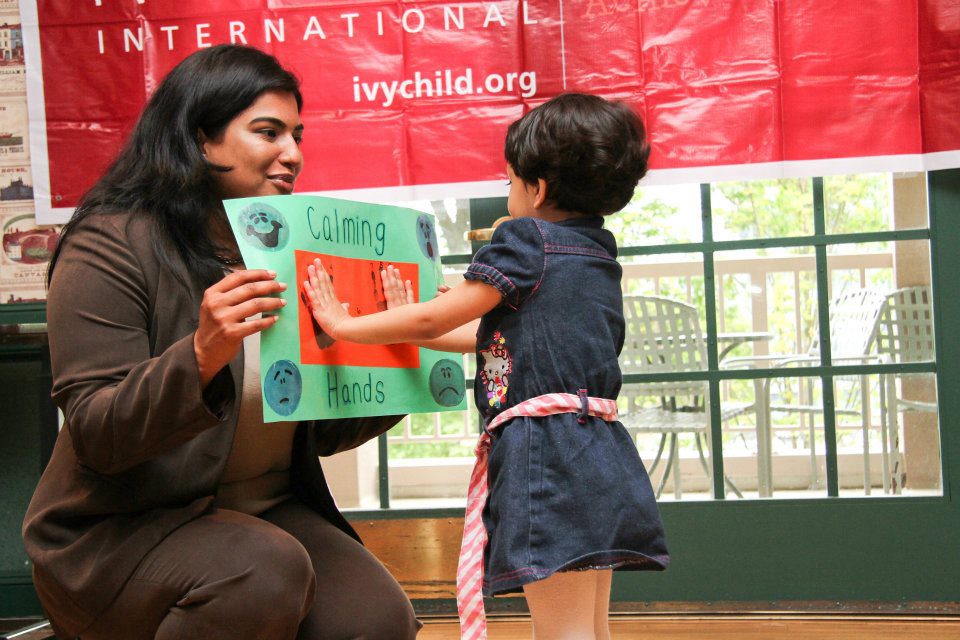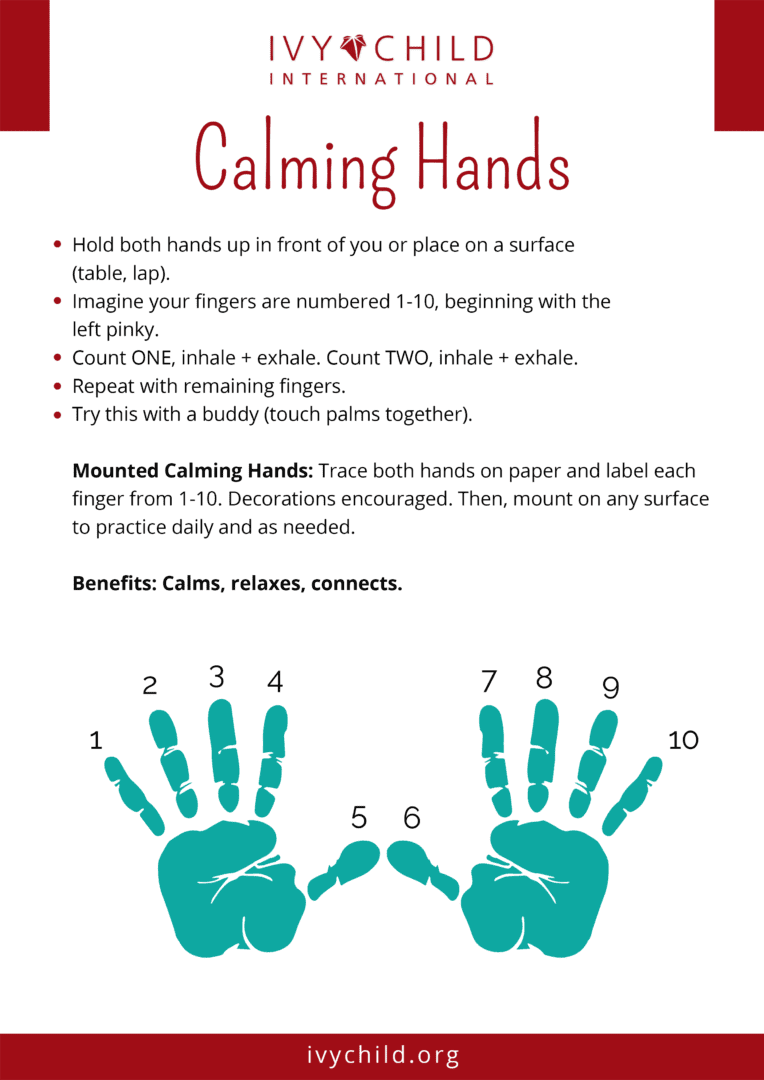Calming Hands A Mindfulness Practice for Kids
Helping Children Find Calm at Their Fingertips
When children feel anxious, overwhelmed, or upset, mindfulness practices like Calming Hands can help them feel safe, grounded, and calm. This simple yet powerful exercise, created by Rose Felix Cratsley, Founder & CEO of Ivy Child International, combines mindful breathing, counting, and handprint art to soothe strong emotions and build emotional resilience.
Mindfulness can be fun, simple, and hands-on—literally! Calming Hands invites children to explore breathing, focus, and creativity through the tactile sensation of their own hands. It’s perfect for caregivers and educators who want to help kids find calm, focus, and emotional balance in a playful and interactive way.
How to Practice Calming Hands
What You’ll Need:
- Paper (large enough for handprints)
- Non-toxic markers, crayons, or paint
- A comfortable and quiet space
Step-by-Step Guide:
- Make the Handprint
Invite your child to trace their hand onto a piece of paper or create a painted handprint. Let them customize it and make it their own: choosing colors or decorating. - Number the Fingers
Together, write the numbers 1 to 10 on the fingers, starting at the thumb and moving outward. - Begin Mindful Breathing
Encourage your child to place their real hands on top of their handprints.- Start (1): Breathe in deeply, then exhale slowly as you count aloud.
- Move to the next finger (2): Breathe in deeply, then exhale slowly as you count again.
- Continue the pattern, breathing in and out for each finger, counting from 1 to 10.
- Repeat As Needed
Encourage your child to take their time and enjoy this exercise, they can trace back through the numbers or start again. Repeating this practice reinforces calmness and focus.
Why It Works
- Breathing Practice: The finger-by-finger breathing technique teaches kids to inhale and exhale deeply while counting from 1 to 10.
- Self-Reflection: Encourages kids to observe how their hands and bodies feel after the practice, reinforcing self-awareness and relaxation.
- Calm and Creative: By combining art and mindfulness, this practice becomes a lasting tool for emotional regulation and relaxation.
How to Adapt for Kids with Sensory Needs
For children with sensory processing needs, encourage them to explore different textures while practicing Calming Hands. Using soft fabric, smooth stones, or textured paper during the exercise can help them connect more deeply with their senses and enhance the calming effect.
Parental Hack
This practice is most effective when caregivers model the activity alongside children, reinforcing the idea that mindfulness is a family activity and ritual. By practicing together, both kids and parents strengthen their emotional resilience and psychological immune system.
Highlights and Benefits
-
- Introduction: Guides children to notice the sensations in their hands and introduces the concept of hands as calming tools.
- Breathing Practice: Teaches kids to inhale and exhale deeply while counting, promoting relaxation and focus.
- Reflection: Helps children reflect on how their body feels post-practice, fostering mindfulness and self-awareness.
- Creative Art: Integrates creativity by making handprints, decorating them, and turning them into visual reminders of calm.
Make Art With Your Handprint
The Calming Hands practice is best paired with an engaging art activity. Children can trace or make handprints, decorate them, and personalize their calming hands. This hands-on activity teaches kids to ease difficult emotions while providing a visual and tactile reminder of the breathing practice. It turns mindfulness into a creative keepsake that kids can return to in stressful moments.
Consider mounting the handprint art on the fridge, bedroom door, or even in the car as a calming tool that everyone can use.
Guided Audio Practice: Use Your Hands to Explore Mindful Breathing
- Calm and Creative: By combining art and mindfulness, this practice becomes a lasting tool for emotional regulation and relaxation.
How to Adapt for Kids with Sensory Needs
For children with sensory processing needs, encourage them to explore different textures while practicing Calming Hands. For example, using soft fabric, smooth stones, or textured paper during the exercise can help them connect more deeply with their senses and enhance the calming effect of the practice.
Parental Hack
This practice is most effective when caregivers model the activity alongside children, reinforcing the idea that mindfulness is a family activity and ritual. By practicing together, both kids and parents strengthen their emotional resilience and psychological immune system.
Highlights and Benefits
- Introduction: Guides children to notice the sensations in their hands and introduces the concept of hands as calming tools.
- Breathing Practice: Teaches kids to inhale and exhale deeply while counting, promoting relaxation and focus.
- Reflection: Helps children reflect on how their body feels post-practice, fostering mindfulness and self-awareness.
- Creative Art: Integrates creativity by making handprints, decorating them, and turning them into visual reminders of calm.
Make Art With Your Handprint
The Calming Hands practice is best paired with an engaging art activity. Children can trace or make handprints, decorate them, and personalize their calming hands. This hands-on activity teaches kids to ease difficult emotions while providing a visual and tactile reminder of the breathing practice. It turns mindfulness into a creative keepsake that kids can return to in stressful moments. Consider mounting the handprint art on the fridge, bedroom door, or even in the car as a calming tool that everyone can use.


